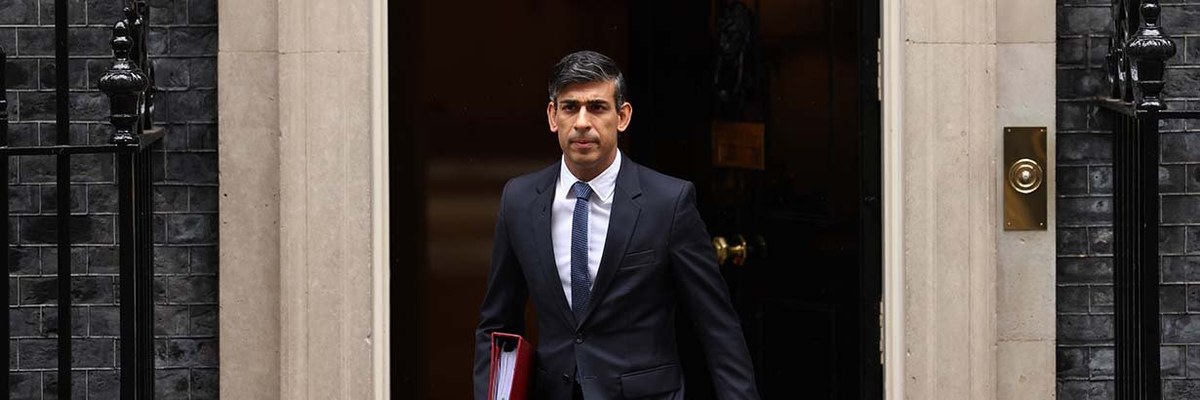The Conservative PM faces the problem of losing voters to either side of his party
With the Conservatives slumping to record low voting intention figures during Liz Truss’s short tenure, when Rishi Sunak became prime minister the only way was up.
One year on, however, and the Conservatives are still around 20 points behind Labour, and suffered some of its worst ever by-election defeats last week.
The key to success for Sunak will be to win back voters who supported his party in 2019 but have since moved away. While it still may be over a year before the country goes to the ballot box, evidence from his first year in power, shows he has done little to change this so far.
Where things were left
To understand the full picture of Sunak’s performance with 2019 Conservative voters, we have to go back one further prime minister - to the end of Boris Johnson’s tenure. Despite a commanding victory in the last election and strong ratings at the start of the pandemic, continuous scandals in the latter half of Johnson’s tenure meant by the time he stepped down he was only holding on to 50%-55% of 2019 Conservative voters. During his final months, most of these lost voters were fairly evenly split between those who were saying they would vote for other parties (about 20%) and those saying they were now unsure how they’d vote (also about 20%).
The loyal Tory vote collapsed even further after just three weeks of Liz Truss, to less than 40%. This translated into an equal increase in the number of 2019 Tory voters saying they’d vote for another party (rising to about 27%) and ‘don’t know’ (again, about 27%). This drastic drop in support was enough to contribute to her resigning as leader after just six weeks in power.
Sunak takes over
Sunak’s first task as leader was to steady the ship and win back some of these ‘lost’ voters. Previous YouGov research shows that the easiest of these two groups to win back would be those who had moved away from the Conservatives in the polls but were yet to commit to another party.
Indeed, Rishi Sunak was quickly able to win back some of those voters, with our first few polls after he became leader showing the proportion saying ‘don’t know’ dropping a few points to around 23%. This was, however, more likely a reflection of him simply not being Liz Truss than approval of his own leadership credentials.
While Sunak has managed to keep the number of 2019 Tory voters saying ‘don’t know’ below 25% throughout his year in charge, this proportion is still only around where it was at the very end of Johnson’s time as leader, and worse than most of his last turbulent year in office.
Sunak has had a harder time winning back those who switched to another party, making virtually no progress across the year compared to where things were under Truss – the figure has remained around 27% of all 2019 Conservative voters. This is also much higher than the number Johnson was losing to other parties in his last month in power, which was around 20%.
While the aggregate number of those moving to other parties under Sunak appear to be about the same as under Truss, the direction in which these voters are moving differs. Under Truss around one in five (around 20%) were switching to a party to the left of the Conservatives such as Labour, the Liberal Democrats or Greens while far fewer voters were switching to Reform UK on the right of the party (about 5%).
In his first couple of months, Rishi Sunak did manage to win back some voters who were saying they’d vote for a more left wing party, dropping this figure to around 15%. Simultaneously though, he lost voters to the right with around 10% saying they’d vote Reform UK. While you don’t want to be losing voters to any party, with Labour and the Lib Dems likely to be the main challenger in most Tory constituencies these voters are twice as valuable in straight head to heads.
Will these voters return?
While the last year may not have been as successful as he would have wanted, Sunak will still be hopeful that he can win back some of these lost voters as he gears up for the general election. Those who say they are currently unsure how they’ll vote may not be satisfied with the Conservatives, but they are also not willing to support a different party at this stage, and so are easier to win back than those lost to other parties. We’ve seen in the past that these voters may return once an election is called. Of course, that doesn’t mean they can be taken for granted, they could also move to another party, or not turn out to vote.
Even if he successfully convinces large numbers of unsure 2019 Conservatives to return at the next election, this wouldn’t be enough to beat Labour. Those who are intending to vote for another party will need far more convincing.
The unique problem Sunak has is that he is trying to win back lost voters on both sides, with similar numbers moving to the left and the right of his party. Setting policies that will appeal to these voters who are ideologically different is incredibly difficult, while aiming for just one side risks losing further voters to the other.
The last decade of British politics has been far too turbulent to make any assumptions ahead of the next election, but on the evidence of his first year in power, Rishi Sunak is going to have to do something pretty spectacular to win back enough of the lost voters he needs to win.
Photo: Getty








